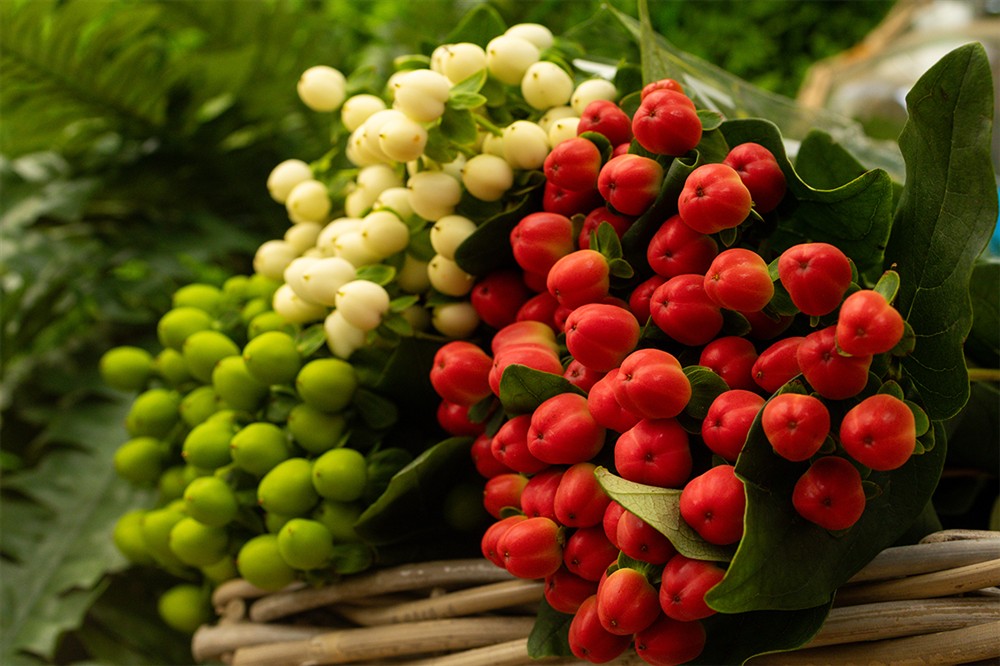Hypericum (St John’s Wort): the underrated workhorse for garden and vase.
If flowers had personalities, Hypericum would be the reliable friend who turns up on time, cleans up after the party and somehow still looks great in every photo. Often called St John’s Wort, Hypericum is a flexible genus of perennial shrubs and subshrubs that brings structure, texture and long-lasting colour to both borders and bouquets. From low, spreading groundcovers to upright shrubs nearing 1.5 metres, there’s a Hypericum to suit almost every garden or design need.

Why florists and gardeners love Hypericum
- Architectural stems and glossy foliage give body to arrangements without stealing the show.
- Bold, cheerful flowers (and later, berries) add seasonal interest and useful colour contrast.
- Long vase life and hardiness make it a practical choice for weddings, events and everyday work in the shop.
- Cost effective — you get impact for very little outlay, which makes it a favourite when sourcing wholesale flowers. (Yes, it’s the unsung hero your bouquets have been waiting for.)
Our selection (what we supply at FlowerSuppliers)
We source a selection of ornamental Hypericum varieties from trusted growers, including flowering forms and berry-producing cultivars in decorative tones. Varieties commonly available to florists include those with small golden flowers and those selected for attractive berries and foliage. If you’re after Hypericum for stems (flowers or berries), check our current stock as vailability can vary with the season.
Growing Hypericum: What actually works.
Hypericum is straightforward if you follow a couple of basics:
Light: most varieties prefer full sun to part shade. In the UK, a site with morning sun and light afternoon shade is often ideal — very hot, exposed spots can scorch some types.
Soil: well drained is non-negotiable. A loam or sandy loam enriched with organic matter is best. Heavy, waterlogged soils are the enemy — they encourage root rot.
Water: water to establish, then moderate. Mature plants are reasonably drought tolerant but perform best with regular moisture during hot spells.
Climate & hardiness: many Hypericum species do well in temperate climates. Choose varieties rated for your local hardiness zone; some species tolerate colder winters better than others.
Pruning & maintenance: prune lightly after flowering to keep a bushy shape and to encourage new stems (which is what you cut for floral use). Remove dead wood and thin congested growth annually.
Pests & disease: generally trouble-free, but watch for aphids and occasional fungal issues in poorly ventilated, wet conditions. Good hygiene and air circulation help.
Note on invasiveness: some species (for example H. perforatum) can naturalise aggressively. If you’re planting in the wild or meadow-style areas, pick non-invasive, garden-approved cultivars.
Leaves, flowers and berries: What to expect.
Hypericum has lance-shaped, glossy leaves and, typically in mid to late summer, clusters of five-petalled yellow flowers with prominent stamens. As summer progresses, many varieties develop attractive berries that persist and provide excellent texture for arrangements. The foliage is a calm, green backdrop, useful when you want colour without competing with focal flowers.

How florists use Hypericum (practical design ideas)
- Textural filler: stems and berries add mid-level texture between large focal flowers (roses, peonies) and delicate fillers (waxflower, ammi).
- Seasonal bouquets: berries give great autumn and winter structure; flowers work beautifully in summer designs.
- Natural, relaxed styles: drift plantings in meadows or casual bouquets benefit from Hypericum’s informal, architectural look.
- Structural installations: good woody stems make Hypericum useful in garlands and larger installations where durability is needed.
- Containers & patio displays: compact varieties do well in pots for patios and terraces.
Conditioning and vase care (for florists & DIYers)
- Cut in the morning when stems are full of water.
- Re-cut stems at a slant and strip any foliage that will sit below the waterline.
- Use flower food or your preferred conditioning solution — Hypericum is robust and responds well to standard conditioning.
- Temperature: keep cool for maximum vase life; berries will last longer in cooler conditions.
- Display: Hypericum stems can last a long time in arrangements — great when you need reliability for events.
Quick troubleshooting
- Leggy, sparse growth: light feed in spring, prune to encourage bushier habit.
- Yellowing leaves: check drainage and watering frequency; avoid waterlogging.
- Poor flowering: ensure adequate light — too much shade reduces blooms.

FAQs (short & useful)
Are Hypericum berries toxic to pets?
Some Hypericum species contain compounds that can be toxic if eaten in quantity. Keep plants and cut stems out of reach of curious pets. If ingestion is suspected, contact your vet.
Is Hypericum a perennial?
Yes. Many species are perennial shrubs or subshrubs. Flowering times and hardiness vary by species, so choose accordingly.
Can you dry Hypericum?
Yes. Berries and stems dry well and retain colour and structure — perfect for dried arrangements.
Is Hypericum invasive?
Some species can naturalise. Avoid planting H. perforatum where it might spread; choose garden cultivars that are non-invasive.
Final notes from the (slightly bossy) florist
Hypericum is one of those plants that makes life easier. It’s structural, reliable and gives you options — flowers, berries and foliage — all from the same stem. If you’re a florist planning weddings or events, or a gardener aiming for low-maintenance impact, consider adding Hypericum to your palette. It’s the kind of ingredient that quietly makes everything else look better.

